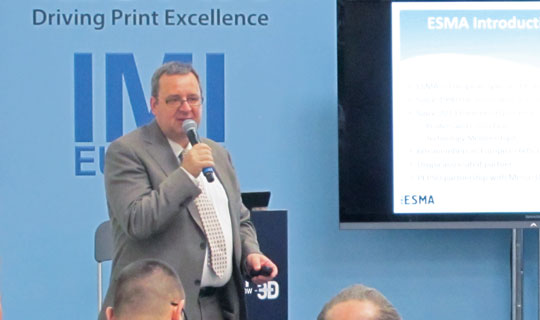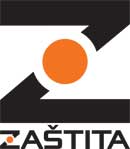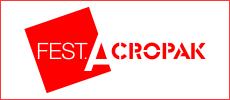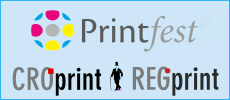«
Povratak na sadržaj
Broj 4 | Godina 2014

Peter Buttiens, General Manager, European Specialist Printing Manufacturers Association (ESMA), Belgium
Budućnost tiska je u njegovoj fleksibilnosti
ESMA is the European Specialist Printing Manufacturers Association that brings together suppliers, printers and consultants. Its objectives are to promote the adoption and correct use of the various specialist printing processes through seminars, public relations, technical trainings and research into specific requirements of printing and imaging technologies used in industrial and graphics processes.
The association is committed to developing higher technical standards for specialist printing processes, and meeting European legal requirements for health, safety and environmental issues.
ESMA was founded 24 years ago as an Association of European Manufacturers of screen printing equipment and suppliers for the ultimate benefit of their customers. Are your goals the same now as they were then, and what have you accomplished so far? Please, introduce your organization.
Today, ESMA is the leading association in Europe for industrial, functional and speciality print for screen and digital processes. ESMA began life as a pure screen printing association. One of its major goals was to ensure the future of screen printing in the face of the rise of digital inkjet technology in the large format area. It became clear that screen printing could do so much more in the graphical large format arena and many new developments were subsequently created for industrial graphical solutions. These ranged from different substrates such as plastics or glass as well as totally new market segments such as automotive, toys and home appliances. The market of IMD and FIM was one of these growth areas, but also brand protection solutions. In 2000 ESMA offered membership to companies manufacturing machinery and consumable supplies for the Digital Imaging process.
How many members do you have today and what has changed since you opened for digital manufacturers?
The market has indeed changed and as expected digital inkjet solutions have been the rising print technology. We have seen large format graphics quickly become the main stream market for digital.
In 2007, when I became the General Manager of ESMA, our association had been involved with the explosive growth of digital printing. By 2009, the association almost doubled in membership.
The start of the economic crisis by the end of 2009 did have an impact on membership but recently, the association grew to 62 - a new record. We are always looking for new members to reflect both regional and sector interest.
Who can become a member, what conditions must be fulfilled?
There are two levels of membership.
The first are voting members who are original supplier manufacturers.
These can be machine manufacturers, pre – and post processing, software, inks, suppliers and much more for screen and digital print processes. They must have an office in Europe and they must fulfil our ‘code of conduct’ association rules. The second group is non-voting members and technology partners. Technology partners must be involved with printing technology, this could be development, support, distribution, sales, training, consultancy or users. We have strong interest from companies looking towards industrial, functional and speciality printing.
What are the unique benefits that ESMA offers to its members? What are the general benefits for manufacturers of printing equipment encouraging them to become a member?
ESMA has several important membership qualities.
We have an excellent relationship with all major exhibitions in Europe and ROW and a special partnership with Messe Düsseldorf as we are the PEPSO (Printed Electronics Products and Solutions) partner for seven different shows. This helps to integrate PE and functional printing vertically in seven different industries. Due to the broadening of our support for less traditional shows for printing, we have developed a plan for pavilions. As a result of the success of these we have now expanded them to printing shows as well. But central to our strategy is our knowledge hub, which we have been gathering with the members, academics, funded projects. Through these we have a lot of information which is important to develop new markets and segments for printing. The knowledge exchange can be at committee meetings, conferences, master classes, training course…
To facilitate this we have three supporting committees - Technical Exchange Committee (TEC) handling conferences, markets, opportunities, best practice, Health, Safety and Environmental
Protection for all chemical regulations within the printing industry in connection with, among others, REACH, CLP (Classification, Labelling and Packaging Regulation) and GHS (Globally Harmonised System) and the Marketing & Promotion Committee that promotes Special Printing Worldwide magazine, the development of the association, and the global marketing and communication development of its members.
One of your tasks is lobbying Brussels for regulations and legislation, relevant to all processes, particularly in health, safety and environmental issues. Can you tell us some more about the regulations you want to be adopted?
We have an excellent committee on Health, Safety and Environmental Protection. Today, we are looking closely at all REACH, GHS, CLP and other regulations from the EU. The biggest challenge is the constant update of the exemption lists of chemicals.
What are the main problems in regulations that cover environmental issues?
There are many regulations which, for example, make export to China difficult. China REACH is even more difficult to handle. It is hard to keep up with the constant stream of required changes but it is also an extra overhead in time, costs, but even more in understanding what to do within the right time frame.
Please share with us some of the figures on European screen printing market.
Within Printed Electronics, screen printing is the leading production technology with 80 % of printed parts. While in direct container printing on glass and plastic, screen printing takes the largest share.
Screen was around 38 % of the industry in 2008, with a drop of nearly 1 % to 2 % in the following years.
By 2018 Screen will take up 32 %, which is still higher than inkjet. For inkjet the story is different. In 2008 the share was only 5 % and it has rapidly grown since. Now it is up to 20 % and by 2018 it will reach 31 %, which is close to the market share of digital.
What was the impact of financial crisis on print industry? Which parts of printing industry suffered the most and is the market recovering well?
The graphics printing market suffered the most but also some specialized areas such as glass were under pressure. The automotive industry made it very difficult for companies involved in printing production for decoration or functional. There is a global shift to new market segments which are less graphical but more industrial oriented.
Looking to different market segments, the leading is Décor and laminate with33 %, followed by Printed Electronics/ Electronics (20 %), while promotional printing takes around 16 %.
Ceramics is just out of the top three, with 10 %. By 2018, Printed Electronics will be number one with almost 45 % and also 3D Printing will take an important share!
How successful are your members in developing new market opportunities through advanced technology support?
Screen printing members have undergone a complete make-over of their business from graphics to industrial in less than two decades. These printers and companies need to follow the market changes, the new requirements, new regulations and legislation. ESMA has been organizing conferences over the past seven years in different fields such as Computer-To-Screen, Glass Print, Membrane Switch, Advanced Functional and Industrial Printing. ESMA brings together printing technology in different segments of the industry and promotes overall printing solutions.
Who attends yours seminars and conferences?
For each conference the main focus is to invite printers (customers of ESMA member manufacturers) and their customers such as brand owners or corporate companies. At AFIP, we had important manufacturers of tablets and smartphones… During GlassPrint we invited important leaders from the glass industry from flat and hollow glass. Also famous beer brands, spirits and special representatives from tableware joined the conference. It is important to bring together all players in the supply chain.
In which ways will inkjet technology have an impact on major industries worldwide?
With the breakthrough of single pass printing at industrial level, ceramic tile printing is being overtaken by inkjet printing. The market now has several suppliers and the profits of machine installations and inks are already in the next segment of the BCG diagram. Several other segments are close to undergoing their own revolution. Labelling and packaging are front runners, with the new digital single pass printers, each label or package can be adapted on an individual level. Other more industrial markets are embracing the digital technology such as container printing. Textile and laminated floor products are among other sectors finding their way in the replacement of the traditional production solutions. However, these markets are not handled by the traditional printing shops.
Some printers consider digital alternatives to be a threat to traditional print. Do you think that those who won’t adopt changes will eventually have to shut their businesses down?
As mentioned before, screen printing had to adapt to survive and screen printers had to adopt new segments. Working more and more in the pure B2B segments they tend to see print both as a process and a product. The few that stayed within graphics have often operated in an alternative segment of profitable applications.
Can you tell us which crucial trends in printing industry will be in the next few years?
Traditional printing shops will become less of a focus for printing suppliers because this segment has reached its saturation level and is downsizing or a market for replacements. Because prices are already extremely low for traditional printed products, it is either the service or the specialization of the printer that becomes the differentiator. Also on the digital printing side, new equipment is capable of reliably printing high volumes at good quality. The biggest profits for printing suppliers will be seen in bringing print into the new industrial segments where printing was previously by other solutions or different print technologies. The flexibility of the whole operation will be the key!
The internet also changed the printing business in a dramatic way, because the user or buyer can be closer to the production. The time to market is shorter, the marketing campaigns change rapidly and the big key focus will be mass individualization of products.
The internet has changed marketing enormously. Now there is as much budget for online marketing as for off line. It is also more important for companies to support cross marketing platforms. Printing will become more creative as the traditional graphics printing, especially large format printing will get more and more competition for digital signage. This will include a new kind of POS and POP systems that combine both elements.
What is your best advice to the printing industry? How can you transform businesses to stay profitable and competitive?
The main word is here specialization on all levels. Printing is only one part, but the whole handling, shipping of finished products needs to be perfect through the whole workflow until it is delivered to the customer. Specialization in new segments is one part but knowing the market, the customers and the real ins and outs of that business environment is the key. Too many companies invest in a nice concept but don’t prepare their go-to market plan; they have no specific orders or contracts. We notice this in markets such as decorative developments on glass, wood and other materials. The choice starts with going for print as a product or print as a process. The first one fits both B2C and B2B depending on the product and the second one is pure B2B in an industrial environment.














